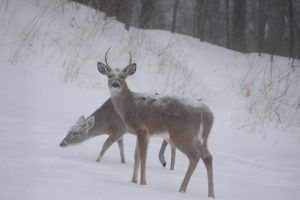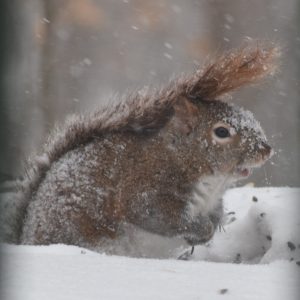How Deer, Squirrels Survive Winter
The weather has turned warm and spring is definitely on its way, but few will forget the single digit temperatures and snow we had in February. Some wild animals hibernate through the winter, while others remain active throughout the year. Observing the White-tailed deer, Illinois’ state mammal, during the recent cold spell might make one wonder how animals adapt to the bitter cold.

Normal body temperature in ruminants, which includes the White-tailed deer, is approximately 101.4˚F. As winter approaches, their fur attains a darker color to absorb more sunlight. Hollow guard hairs provide protection and insulation, but it’s really the finer, wool-like hair underneath that affords the greatest insulation value. There aren’t as many outer guard hairs but they are hollow, thicker and twice as long. Their inner coat contains over 5,000 hairs per square inch and works incredibly well at insulating their body. Their skin also produces an oil that makes their fur water repellent, providing protection against cold, wet snow.
Fat reserves can provide much of a whitetail’s required wintertime calories. A whitetail entering winter with ample fat reserves can withstand a 30% weight loss and still survive. Foods like acorns help deer accumulate the necessary fat reserves to pull them through the winter.
Much like deer, squirrels rely on fat stores, built up by consuming huge amounts of food during autumn, to get them through the winter. All squirrels develop a thicker coat for winter. Squirrels also rely on body heat in order to survive freezing temperatures. One way they do this is to share a nest and stay close to each other for warmth. They also make use of shivering to survive the cold. Shivering is a physical reaction to cold that generates body heat.

Squirrels spend the fall season building up their food stores so that they do not have to forage for food on a daily basis, similar to humans who run to the grocery store for bread, milk and eggs before a snowstorm. American red squirrels will build up a single massive central food cache called a midden and will spend the winter fiercely defending its single food supply. Grey squirrels will create multiple food caches in case one of them becomes compromised.
No need to worry about our wild winter visitors. Nature takes care of them.
CLIFFTOP, a local nonprofit organization, is focused on preserving and protecting area bluff lands.
A version of this article appeared in the March 17, 2021 edition of the Republic-Times.
© 2021 all content rights reserved Clifftop NFP
Comments are currently closed.
